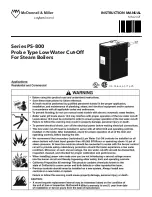
20
8 START
UP
8.1 PRELIMINARY
CHECKS
Before starting the boiler, check that:
- The
rating plate
specifications and power supply network (electricity, water, gas) specifications correspond;
- The
burner
power range
is compatible with the power of the boiler;
-
The boiler room also contains the instructions for the burner;
- The
flue gas exhaust pipe
is operating correctly;
- The
air inlet supply
is well dimensioned and free from any obstacle;
- The
boiler door
, the
smoke box
and the
burner plate
are closed in order to provide a complete flue gas seal;
-
The system is
full of water
and that any
air pockets
have therefore been eliminated;
- The
anti-freeze
protections are operative;
- The
water
circulation pumps
are operating correctly.
-
The expansion vessel and the safety valve(s) have been connected correctly (with no interception) and are
properly operating.
-
Check the electrical parts and thermostat operation.
8.2 WATER
TREATMENT
If the boiler is to be installed in an existing system where there could be frequent losses from the system
or if the hardness of the water is greater than 10 F, it will be necessary to use a filter and a softener for sys-
tem water and control the pH above 8-9.
The most common phenomena that occur in heating systems are:
- Scaling
Scale obstructs heat transfer between the combustion gases and the water, causing an abnormal increase in
the temperature of the metal and therefore reducing the life of the boiler.
Scale is found mostly at the points where the wall temperature is highest and the best remedy, at construction
level, is to eliminate areas that overheat.
Scale creates an insulating layer, which reduces the thermal transfer of the boiler, affecting system efficiency. This
means that the heat produced by burning the fuel is not fully transferred and is lost to the flue.
Scale diagram
Key
%
% fuel not used
mm
mm scale
- Corrosion on the water side
Corrosion of the metal surfaces of the
boiler on the water-side is due to the
passage of dissolved iron through its
ions (Fe+). In this process the presence
of dissolved gases and in particular of
oxygen and carbon dioxide is very im-
portant. Corrosion often occurs with sof-
tened or de-mineralised water, which has a more aggressive effect on iron (acid water with Ph <7): in these
cases, although the system is protected from scaling, it is not protected against corrosion and the water must be
treated with corrosion inhibitors.
8.3 FILLING THE SYSTEM
The water must enter the system as slowly as possible and in a quantity proportional to the air bleeding capacity of
the components involved.
In the case of a system with
closed expansion vessel
, water must be let in until the pressure gauge indicator
reaches the static pressure value, pre-set by the vessel. Heat the water to maximum temperature. During this op-
eration, the air contained in the water is released through the automatic air separators or through manual bleed
valves. The water discharged from the system with elimination of the air is made up by the automatic or manual-
filling valve.







































